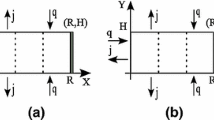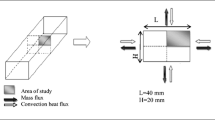Abstract
Cracking as a result of non-uniform deformation during drying is one of defects that may occur during drying and has to be dealt with by proper drying treatment. In the current study the effect of initial condition has been investigated on stress-strain induced by drying. The convective drying of a porous clay-like material has been simulated by using a mathematical model. Mass and heat transfer along with the mechanical behavior of the object being dried make the phenomenon a highly coupled problem. The coupling variables are the solid displacement, moisture content and temperature of the porous medium. A numerical solution is sought and employed to predict the influence of initial conditions of material on the drying induced stresses, the moisture content, and the temperature variations. Simulation results showed that increasing the initial temperature is an effective way to reduce the stresses induced by drying and to obtain products with good quality without significant change in drying curve and in comparison this is more effective than intermittent drying.


















Similar content being viewed by others
References
Liu X, Lee DJ (2015) Some recent research and development in drying technologies: product perspective. Dry Technol 33:1339–1349
Musielak G, Mierzwa D (2009) Permanent strains in clay-like material during drying. Dry Technol 27:894–902
Khalili K, Ahmadi-Brooghani SY, Bagherian M (2014) Experimental and numerical study of the ceramic drying process and cracking. J Solid Fluid Mech 4:119–129
Heydari M, Khalili K (2016) Investigation on the effect of Young’s modulus variation on drying-induced stresses. Transp Porous Med 112:519–540
Kowalski SJ (2003) Thermomechanics of drying processes. Springer-Verlag, Berlin Heidelberg
Vasić M, Grbavčić Ž, Radojević Z (2014) Determination of the moisture diffusivity coefficient and mathematical modeling of drying. Chem Eng Process Process Intensif 76:33–44
Islam MR, Mujumdar AS (2003) Role of product shrinkage in drying rate predictions using a liquid diffusion model. Int Commun Heat Mass Transfer 30:391–400
Silva WP, da Silva CMDP, da Silva LD, Farias VSO (2013) Drying of clay slabs: experimental determination and prediction by two-dimensional diffusion models. Ceram Int 39:7911–7919
Efremov GI (2002) Drying kinetics derived from diffusion equation with flux-type boundary conditions. Dry Technol 20:55–66
da Silva WP, de Oliveira Farias VS, de Araújo Neves G, de Lima AGB (2012) Modeling of water transport in roof tiles by removal of moisture at isothermal conditions. Heat Mass Transf 48:809–821
Mihoubi D, Bellagi A (2009) Stress generated during drying of saturated porous media. Transp Por Med 80:519–536
Oztop HF, Akpinar EK (2008) Numerical and experimental analysis of moisture transfer for convective drying of some products. Int Commun Heat Mass Transfer 35:169–177
Esfahani JA, Majdi H, Barati E (2014) Analytical two-dimensional analysis of the transport phenomena occurring during convective drying: apple slices. J Food Eng 123:87–93
Lewis RW, Strada M, Comini G (1977) Drying-induced stresses in porous bodies. Int J Numer Methods Eng 11:1175–1184
Kowalski SJ, Pawlowski A (2010) Modeling of kinetics in stationary and intermittent drying. Dry Technol 28:1023–1031
Kowalski SJ, Szadzińska J (2012) Non-stationary drying of ceramic-like materials controlled through acoustic emission method. Heat Mass Transf 48:2023–2032
Itaya Y, Okouchi K, Mori S (2001) Effect of heating modes on internal strain-stress formation during drying of molded ceramics. Dry Technol 19:1491–1504
Banaszak J, Kowalski SJ (2005) Theoretical and experimental analysis of stresses and fractures in clay like materials during drying. Chem Eng Process Process Intensif 44:497–503
Musielak G (2000) Influence of the drying medium parameters on drying induced stresses. Dry Technol 18:561–581
Manel BA, Mihoubi D, Jalila S, Ahmed B (2014) Strain–stress formation during stationary and intermittent drying of deformable media. Dry Technol 32:1245–1255
Augier F, Coumansa WJ, Hugget A, Kaasschieter EF (2002) On the risk of cracking in clay drying. Chem Eng J 86:133–138
Khalili K, Heydari M (2012) Studying the effect of part thickness on cracking during drying process. J Modares Mech Eng 12:103–116
Pourcel F, Jomaa W, Puiggali JR, Rouleau L (2007) Criterion for crack initiation during drying: alumina porous ceramic strength improvement. Dry Technol 172:120–127
Mermerdaş K, Güneyisi E, Gesoğlu M, Özturan T (2013) Experimental evaluation and modeling of drying shrinkage behavior of metakaolin and calcined kaolin blended concretes. Constr Build Mater 43:337–347
Musielak G, Śliwa T (2015) Modeling and numerical simulation of clays cracking during drying. Dry Technol 33:1758–1767
Belleghem MV, Steeman M, Janssen H, Janssens A, Paepe MD (2014) Validation of a coupled heat, vapour and liquid moisture transport model for porous materials implemented in CFD. Build Environ 81:340–353
Chemkhi S, Zagrouba F (2005) Water diffusion coefficient in clay material from drying data. Desalination 18:491–498
Musielak G, Kieca A (2009) Temperature dependence of the moisture diffusion coefficient in a high moisture content material. Chem Process Eng 30:231–242
Mujumdar AS, Devahastin S (2000) Fundamental principles of drying. Exergex, Brossard
Ketelaars AAJ (1993) Drying Deformable Media, Kinetics, Shrinkage and Stress. PhD Thesis. Eindhoven, University of Eindhoven
Kowalski SJ (2000) Rate of drying and stresses in the first period of drying. Dry Technol 18:583–600
Banaszak J, Kowalski SJ (2002) Drying induced stresses estimated on the base of elastic and viscoelastic models. Chem Eng J 86:139–143
Heydari M, Khalili K (2015) Modeling enhancement and simulation of distortion in drying process. J Modares Mech Eng 15:291–301
Sonntag RE, Borgnakke C, Van Wylen GJ, Van Wyk S (1998) Fundamentals of thermodynamics, vol 6. Wiley, New York
Stull R (2011) Wet-bulb temperature from relative humidity and air temperature. J Appl Meteorol Climatol 50:2267–2269
Brosnan DA, Robinson GC (2003) An introduction to drying of ceramics. The American Ceramic Society, Westerville
Khalili K, Heydari M (2014) Drying clay bricks with variable Young's modulus. Procedia Technol 12:382–387
Kowalski SJ (2001) Thermomechanical approach to shrinking and cracking phenomena in drying. Dry Technol 19:731–765
Couture F, Laurent S, Roques MA (2007) Drying of two-phase media: simulation with liquid pressure as driven force. AICHE J 53:1703–1717
Kowalski SJ, Rybicki A (2007) The vapour–liquid interface and stresses in dried bodies. Transp Porous Med 66:43–58
Kowalski SJ, Banaszak J, Rybicki A (2010) Plasticity in materials exposed to drying. Dry Technol 65:5105–5116
Mihoubi D, Bellagi A (2012) Modeling of heat and moisture transfers with stress–strain formation during convective air drying of deformable media. Heat Mass Transf 48:1697–1705
Chemkhi S, Jomaa W, Zagrouba F (2009) Application of a coupled thermo-hydro-mechanical model to simulate the drying of non-saturated porous media. Dry Technol 27:842–850
Mujumdar AS (2006) Handbook of industrial drying, third edn. CRC press, Boca Raton
Khalfaoui K, Chemkhi S, Zagrouba F (2013) Modeling and stress analysis during drying of a deformable and saturated porous medium. Dry Technol 31:1124–1137
Hammouda I, Jlassi K, Mihoubi D (2015) Changes in the physicomechanical characteristics of a ceramic paste during drying. Comptes Rendus Mécanique 343:419–428
da Silva WP, da Silva LD, de Oliveira Farias VS, da Silva CMDP (2013) Water migration in clay slabs during drying: a three-dimensional numerical approach. Ceram Int 39:4017–4030
Shokri N, Or D (2011) What determines drying rates at the onset of diffusion controlled stage-2 evaporation from porous media?. Water Resour Res 47:1–8
Shokri N, Lehmann P, Or D (2009) Critical evaluation of enhancement factors for vapor transport through unsaturated porous media. Water Resour Res 45:1–9
Couture F, Laurent S, Roques MA (2007) Drying of two-phase media: simulation with liquid pressure as driven force. AICHE J 53(7):1703–1717
Dincer I, Zamfirescu C (2015) Drying phenomena: theory and applications. John Wiley & Sons, Hoboken
Kowalski SJ, Pawłowski A (2011) Intermittent drying of initially saturated porous materials. Chem Eng Sci 66(9):1893–1905
Itaya Y, Mori S, Hasatani M (1999) Effect of intermittent heating on drying-induced strain-stress of molded clay. Dry Technol 17(7–8):1261–1271
Author information
Authors and Affiliations
Corresponding author
Rights and permissions
About this article
Cite this article
Heydari, M., Khalili, K. & Ahmadi-Brooghani, S.Y. Studying the effect of material initial conditions on drying induced stresses. Heat Mass Transfer 54, 341–352 (2018). https://doi.org/10.1007/s00231-017-2132-2
Received:
Accepted:
Published:
Issue Date:
DOI: https://doi.org/10.1007/s00231-017-2132-2




